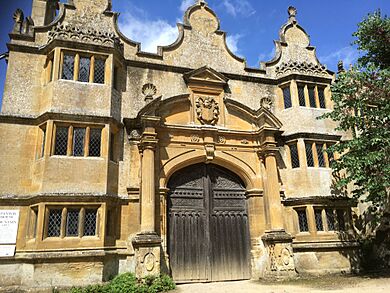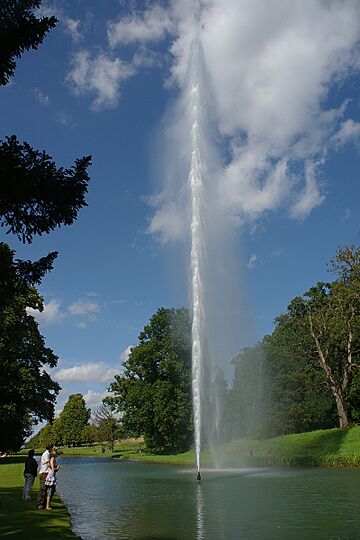Stanway House facts for kids
Quick facts for kids Stanway House |
|
|---|---|

Stanway House front, 2006
|
|
| General information | |
| Town or city | Stanway, Gloucestershire |
| Country | England |
| Coordinates | 51°59′23″N 1°54′45″W / 51.98981°N 1.91237°W |
| Opened | late 16th and early 17th century |
| Owner | James Charteris, 13th Earl of Wemyss |
|
Listed Building – Grade I
|
|
| Official name | Stanway House |
| Designated | 4 July 1960 |
| Reference no. | 1154381 |
| Official name | Stanway House |
| Designated | 28 February 1986 |
| Reference no. | 1000480 |
Stanway House is a beautiful old country house in Gloucestershire, England. It's built in the Jacobean style, which was popular in the late 1500s and early 1600s.
For 800 years, Stanway House belonged to Tewkesbury Abbey, a religious community. After that, the Tracy family and their relatives, the Earls of Wemyss and March, have owned it for 500 years.
The house was mostly built in the late 1500s and early 1600s for the Tracy family. It's considered a very important historical building, known as a Grade I listed building. Unlike many old houses, its main rooms are in an L-shape. The gatehouse, a grand entrance, was added around 1630. The house is made from yellow stone from a place called Guiting.
The current owner, James Charteris, 13th Earl of Wemyss, has been working to restore the house for many years. You can visit Stanway House and its gardens during certain times in the summer.
Contents
History of Stanway House
The history of Stanway House goes back a very long time, even to the year 715! It was given to Tewkesbury Abbey by two Saxons named Odo and Dodo.
In 1533, the land was leased to Richard Tracy. He became friends with Thomas Cromwell, a powerful person who was changing how religious communities worked. Cromwell helped Richard Tracy get the lease for the land very quickly.
Records from 1291 show that the estate had three mills for grinding corn. It also had a mill for processing wool from the abbey's many sheep. This wool mill was later changed to grind corn in the late 1600s. Today, it's known as the Stanway Watermill.
Work on the house itself began around 1580. It was built on the remains of an even older house. Paul Tracy, Richard Tracy's son, started this construction. Paul's son, Sir Richard Tracy, added the impressive triple-gabled gateway in 1630. Later, John Tracy, who owned the house from 1724 to 1735, likely added the beautiful water features.
J. M. Barrie, the famous writer who created Peter Pan, loved visiting Stanway House. He stayed there often during the summers in the 1920s, until 1932. Today, it is the family home of James Charteris, 13th Earl of Wemyss.
Exploring the Estate
Beautiful Gardens
The gardens at Stanway House are also very special and are listed as Grade I on the Register of Historic Parks and Gardens. This means they are historically important. The estate even has its own brewery, which is an original feature from the Elizabethan era. It has been brought back to life!
Wider Estate Features
Part of the Stanway Estate includes Cutsdean Quarry. This is a nature reserve and an important wildlife area in the Cotswolds. The estate's watermill, which is just outside the main grounds, has been fully restored. It now grinds flour, just like it did in the past.
Important Historic Buildings
Besides the main house, several other buildings on the estate are also listed as Grade I. These include the gatehouse, the entrance courtyard gates, and the ancient tithe barn. The tithe barn was built around 1370 for Tewkesbury Abbey. It was restored in 1927, helping to preserve its long history.
The Amazing Stanway Fountain
The Long Canal at Stanway was filled in around 1850. However, it was restored in the early 2000s. This restoration was important for creating the incredible Stanway Fountain. The mill pond was also cleaned out, and eight other ponds and a waterfall were fixed up around the same time.
The Stanway Fountain officially opened on June 5, 2004. It's a single-jet fountain that shoots water over 300 feet (about 91 meters) into the air! This makes it the tallest fountain in Britain. It's also the tallest gravity-fed fountain in the world. This means it uses the natural force of water falling from a high place, not a pump.
The fountain gets its water from a huge reservoir that holds 100,000 imperial gallons (about 454,600 liters). This reservoir is located 530 feet (about 162 meters) above the canal where the fountain sits. A long pipe, about 2 kilometers (1.2 miles) long and 12 inches (30 cm) wide, carries the water to the fountain's bronze nozzle.
Stanway House in Movies and TV
Stanway House has been a popular place for filming movies and TV shows. You might have seen it in:



